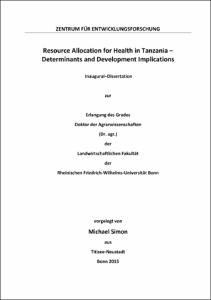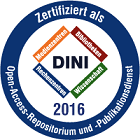Simon, Michael: Resource Allocation for Health in Tanzania – Determinants and Development Implications. - Bonn, 2015. - Dissertation, Rheinische Friedrich-Wilhelms-Universität Bonn.
Online-Ausgabe in bonndoc: https://nbn-resolving.org/urn:nbn:de:hbz:5n-39668
Online-Ausgabe in bonndoc: https://nbn-resolving.org/urn:nbn:de:hbz:5n-39668
@phdthesis{handle:20.500.11811/6233,
urn: https://nbn-resolving.org/urn:nbn:de:hbz:5n-39668,
author = {{Michael Simon}},
title = {Resource Allocation for Health in Tanzania – Determinants and Development Implications},
school = {Rheinische Friedrich-Wilhelms-Universität Bonn},
year = 2015,
month = apr,
note = {The optimal allocation of scarce resources for health improvement is a crucial factor to lower the burden of disease and to strengthen the productive capacities of people living in developing countries. This research project aims to devise tools in narrowing the gap between the actual allocation and a more efficient allocation of resources for health in the case of Tanzania. Firstly, the returns from alternative government spending across sectors such as agriculture, water etc. are analysed. Maximisation of the amount of Disability Adjusted Life Years (DALYs) averted per dollar invested is used as criteria. A Simultaneous Equation Model (SEM) is developed to estimate the required elasticities. The results of the quantitative analysis show that the highest returns on DALYs are obtained by investments in improved nutrition and access to safe water sources, followed by spending on sanitation.
Secondly, focusing on the health sector itself, scarce resources for health improvement create the incentive to prioritise certain health interventions. Using the example of malaria, the objective of the second stage is to evaluate whether interventions are prioritized in such a way that the marginal dollar goes to where it has the highest effect on averting DALYs. PopMod, a longitudinal population model, is used to estimate the cost-effectiveness of six isolated and combined malaria intervention approaches. The results of the longitudinal population model show that preventive interventions such as insecticide–treated bed nets (ITNs) and intermittent presumptive treatment with Sulphadoxine-Pyrimethamine (SP) during pregnancy had the highest health returns (both US$ 41 per DALY averted).
The third part of this dissertation focuses on the political economy aspect of the allocation of scarce resources for health improvement. The objective here is to positively assess how political party competition and the access to mass media directly affect the distribution of district resources for health improvement. Estimates of cross-sectional and panel data regression analysis imply that a one-percentage point smaller difference (the higher the competition is) between the winning party and the second-place party leads to a 0.151 percentage point increase in public health spending, which is significant at the five percent level. In conclusion, we can say that cross-sectoral effects, the cost-effectiveness of health interventions and the political environment are important factors at play in the country’s resource allocation decisions. In absolute terms, current financial resources to lower the burden of disease in Tanzania are substantial. However, there is a huge potential in optimizing the allocation of these resources for a better health return.},
url = {https://hdl.handle.net/20.500.11811/6233}
}
urn: https://nbn-resolving.org/urn:nbn:de:hbz:5n-39668,
author = {{Michael Simon}},
title = {Resource Allocation for Health in Tanzania – Determinants and Development Implications},
school = {Rheinische Friedrich-Wilhelms-Universität Bonn},
year = 2015,
month = apr,
note = {The optimal allocation of scarce resources for health improvement is a crucial factor to lower the burden of disease and to strengthen the productive capacities of people living in developing countries. This research project aims to devise tools in narrowing the gap between the actual allocation and a more efficient allocation of resources for health in the case of Tanzania. Firstly, the returns from alternative government spending across sectors such as agriculture, water etc. are analysed. Maximisation of the amount of Disability Adjusted Life Years (DALYs) averted per dollar invested is used as criteria. A Simultaneous Equation Model (SEM) is developed to estimate the required elasticities. The results of the quantitative analysis show that the highest returns on DALYs are obtained by investments in improved nutrition and access to safe water sources, followed by spending on sanitation.
Secondly, focusing on the health sector itself, scarce resources for health improvement create the incentive to prioritise certain health interventions. Using the example of malaria, the objective of the second stage is to evaluate whether interventions are prioritized in such a way that the marginal dollar goes to where it has the highest effect on averting DALYs. PopMod, a longitudinal population model, is used to estimate the cost-effectiveness of six isolated and combined malaria intervention approaches. The results of the longitudinal population model show that preventive interventions such as insecticide–treated bed nets (ITNs) and intermittent presumptive treatment with Sulphadoxine-Pyrimethamine (SP) during pregnancy had the highest health returns (both US$ 41 per DALY averted).
The third part of this dissertation focuses on the political economy aspect of the allocation of scarce resources for health improvement. The objective here is to positively assess how political party competition and the access to mass media directly affect the distribution of district resources for health improvement. Estimates of cross-sectional and panel data regression analysis imply that a one-percentage point smaller difference (the higher the competition is) between the winning party and the second-place party leads to a 0.151 percentage point increase in public health spending, which is significant at the five percent level. In conclusion, we can say that cross-sectoral effects, the cost-effectiveness of health interventions and the political environment are important factors at play in the country’s resource allocation decisions. In absolute terms, current financial resources to lower the burden of disease in Tanzania are substantial. However, there is a huge potential in optimizing the allocation of these resources for a better health return.},
url = {https://hdl.handle.net/20.500.11811/6233}
}









